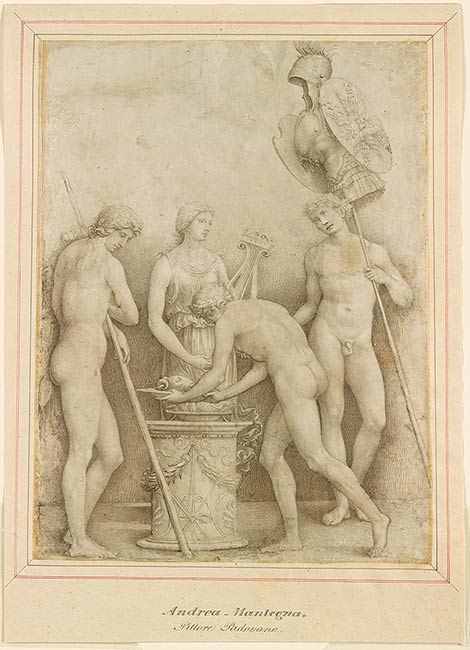
At the cusp of the sixteenth century, Francia was arguably the preeminent painter in Bologna. The city’s large and powerful merchant class, conjoined with a newly emerging aristocracy, fostered a humanist intellectual climate of an antiquarian bent that went hand in hand with the collecting of art and antiquities. It was a tradition that manifested itself not so much as a pure and strict imitation of the antique but rather one that dared to reconceive the ancient world. Artists such as Francia would reconfigure meticulously copied details from antique sources into vital and original motifs and images.
Intended to evoke classical antiquity and learning rather than to depict a specific subject, Francia’s Scene of Antique Sacrifice is a compilation of figural types inspired by Roman and Greek reliefs, sculptures, and medal reverses. The female figure, for instance, likely is based on a representation of Erato, the muse of lyric and love poetry, or of Terpsichore, the muse of dancing and song, both of whom typically are represented with the same attribute, a lyre. The trophy carried by the male nude at right derives from antique military scenes, and the nude in profile leaning on a staff at the far left is reminiscent of mourners on antique Greek funerary reliefs. At the same time, the figures relate closely in style and pose to the protagonists in Francia’s religious compositions: the male nude at left echoes the figure of a shepherd in Francia’s 1499 Nativity, now in the Pinacoteca Nazionale in Bologna.
The artist animated the marmoreal surface of the figures in the Morgan drawing with small, delicate brushstrokes, bestowing on them the vitality of a living presence. They are set off by the carefully brushed-in dark background. A drawing by Francia in the Hermitage, Saint Petersburg, represents a similar but slightly smaller scene of an antique sacrifice with four classically garbed figures.1 It varies the composition by reversing the two male nudes of the foreground, moving the female figure to the left, adjusting her pose to hold a spear instead of a musical instrument and including behind the altar a second female figure with a helmet (perhaps Minerva) instead of the male nude depicted here at the far right. The Morgan and Hermitage sheets belong to a small group of highly finished drawings by Francia that must have been created as precious works of art destined for erudite private collectors. Most of these studies, such as the fine Judgment of Paris in the Albertina, Vienna,2 are on parchment and represent classically inspired subjects, though the Morgan’s Judith Passing the Head of Holofernes to Her Maid (see I, 94) is a magnificent example of this type with a biblical subject. Clearly predating the introduction of modern Roman classicism to Bologna, which was signaled by the arrival in 1515 of Raphael’s St. Cecilia altarpiece, the group has been dated ca. 1500–1504 by Faietti on grounds of style.3 As is the case with many drawings by Francia, this rare sheet was also once thought to be by Andrea Mantegna. By the time the catalogue of the Fairfax Murray collection was published, however, its correct author had been recognized.
—REP
Footnotes:
- Hermitage, Saint Petersburg, inv. 4795, from the Cobenzl collection. See Dobroklonsky 1936, 29–30 (as Francia). The Francia attribution seems correct, though more recently Faietti proposed an anonymous Venetian-Lombard artist of the fifteenth century (Bologna 1988, 256); see also Emilio Negro in Negro and Roio 1998, 101 (as Francia).
- Inv. 4859. See Bologna 1988, no. 67.
- Bologna 1988, 256.
Inscribed on mount, beneath drawing, in pen and black ink, "Andrea Mantegna, / Pittore Padovano".
Ottley, William Young, 1771-1836, former owner.
Lawrence, Thomas, Sir, 1769-1830, former owner.
Robinson, J. C. (John Charles), Sir, 1824-1913, former owner.
Murray, Charles Fairfax, 1849-1919, former owner.
Morgan, J. Pierpont (John Pierpont), 1837-1913, former owner.
Rhoda Eitel-Porter and and John Marciari, Italian Renaissance Drawings at the Morgan Library & Museum, New York, 2019, no. 14.
Selected references: Cartwright Ady 1881, 93; Fairfax Murray 1905-12, 1: no. 95; Frizzoni 1915a, 9, 11; Saxl 1938-39, 366n2; Winner 1968, 195ff.; Los Angeles 1976, no. 76; Northampton 1978, no. 108; Fortunati Pietrantonio 1986, 1:4, 18; Bologna 1988, no. 64; Faietti 1993, 179-80; Schulze Altcappenberg 1995, 94; Ekserdjian 1997, 266; Paris 2001, under no. 5; Jacobs 2005, 39; Munich 2008-9, no. 5; Bologna 2018, 66.
Collection J. Pierpont Morgan : Drawings by the Old Masters Formed by C. Fairfax Murray. London : Privately printed, 1905-1912, I, 95, repr.
100 Master drawings from the Morgan Library & Museum. München : Hirmer, 2008, no. 5, repr. [Rhoda Eitel-Porter]
